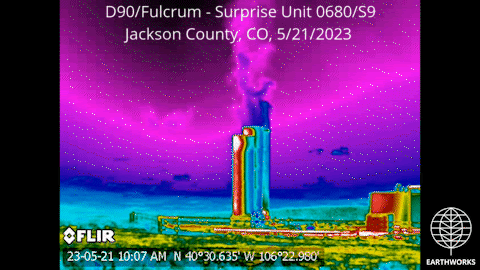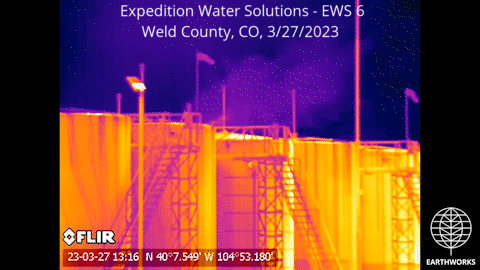
Earthworks Documented Harmful Pollution at One Quarter of Oil and Gas Facilities Surveyed in 2023
In 2023, Earthworks conducted 288 surveys with an optical gas imaging (OGI) camera at 171 oil and gas facilities in Colorado, including well sites, compressor stations, storage facilities, waste disposal facilities, and gas plants. We observed methane and ozone-forming pollution during 67 of those surveys at 46 separate facilities due to venting storage tanks, inefficient combustion, malfunctioning or leaking equipment, and pre production activities like drilling and fracking. This means that we documented the release of harmful pollutants during a quarter of our surveys and at a quarter of the facilities we surveyed, which is comparable to our 2022 survey findings.
Since current regulations do not prohibit many polluting activities such as the emissions associated with engines that power drilling and fracking, we only shared 29 of the 67 observations with the Air Pollution Control Division (APCD). These 29 observations either identified a potential compliance issue and/or indicated a possible equipment malfunction or leak.

Mirroring our 2022 survey results, 87% of these observations consisted of evidence of uncontrolled emissions from tanks or emissions from inefficient combustion in enclosed combustion devices, flares, or burners. The remaining observations consisted of evidence of emissions from unidentifiable sources.
One-third of Pollution Events Earthworks Shared with Regulators Resulted in Operators Finding and Fixing Issues
Again, in line with our 2022 results, about a third of these observations, once shared with operators by the APCD, resulted in operators conducting inspections and identifying issues to correct such as replacing broken valves or repairing pilot lights in malfunctioning burners. And, once more, only a few of these observations prompted APCD staff to conduct an onsite inspection of a facility (3 of 29).

Main Takeaways
In 2023, after years of advocacy from Earthworks and community members, APCD started to publicly display the results of investigations prompted by evidence and concerns shared with the agency by community members (CDPHE oil and gas concern response dashboard). This data corroborates our findings: most concerns about oil and gas facilities lead to onsite inspections by operators but not by state regulators. This means that community members have to rely on oil and gas operators to act in good faith, conduct thorough onsite inspections of their facilities, and self-report any issues they identify and correct. In an ideal world, this might be enough to keep communities safe from harmful pollution, but the ideal world does not exist for communities dealing with chronic polluters (the story of one such community).
Many polluting activities occur at oil and gas facilities that are cause for concern in communities but are not violations of air quality rules – so state regulators have limited authority to intervene. As we highlighted above, we shared less than half of our observations of pollution in 2023 with the APCD because in many instances we determined the emissions were likely not the result of a compliance issue or malfunction. This includes most emissions that occur during drilling and fracking but also most emissions that occur during maintenance activities.
The video below displays a geyser of pollution we filmed from over a quarter of a mile away as an operator was depressurizing a well in order to perform maintenance. Despite being one of the more significant events we recorded in 2023, this pollution was not the result of a violation. However, just because no rules were violated does not mean that this pollution is any different than pollution that is the result of a specific compliance issue. Polluting activities like this have negative consequences for the climate, for regional air quality, and for anyone nearby who may suffer direct health impacts, regardless of whether the operator complied with existing regulations.

What’s Next
We must continue to advocate for more accountability and transparency from state regulators in responding to community concerns about oil and gas facilities. Whenever possible, onsite inspections of facilities should be prioritized because community members expect regulatory oversight to ensure that operators are complying with rules.
There will be many opportunities this year for Colorado to continue to refine oil and gas regulations, such as in adopting a state implementation plan for the EPA’s new methane rules. During these processes we must continue to highlight the fact that compliance with air quality regulations does not always mean that operators are being held accountable for harmful pollution. Not only do we need to empower regulators to account for more polluting activities (a goal we are actively encouraging Colorado lawmakers to take up), we also need to acknowledge that oil and gas production will always result in some pollution. A transition away from fossil fuel energy is necessary to address climate change and to ensure a clean, healthy environment for all Coloradans.
